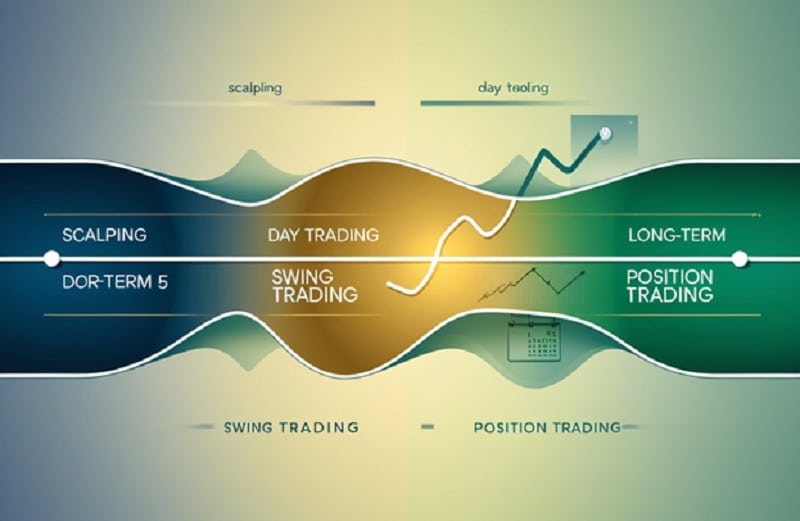Find out what position trading involves and how it helps investors make money from important market changes while reducing daily risks.
Introduction
In financial markets, people involved in trading and investing usually pick different strategies depending on their objectives and how much risk they can handle. Certain traders enjoy making quick trades every few minutes. Some prefer day trading which means they open and close their positions within a single day. Swing trading looks for short- to medium-term changes in price which can take a few days to a few weeks. Another option is position trading which involves holding investments for a long period.
Long-term trading strategies help serious investors achieve a steady increase in wealth. Instead of reacting to daily price changes, these approaches look for major trends and stay with them patiently.
However, what is position trading and why is it suited for long-term investors? This article will cover the main ideas, advantages, tools and techniques of position trading so you can see if it fits your needs.
What Is Position Trading?

In position trading, investors keep an asset such as stocks, forex or commodities for a long period which can be several weeks, months or even years. The aim is to take advantage of big price changes caused by important economic trends or market cycles.
Unlike day trading and swing trading, position trading pays less attention to the daily changes in price. Rather, it focuses on the overall trend by sticking with it as long as it holds up. For this reason, position trading appeals to investors who want to trade without checking the markets all the time.
The main ideas in position trading are to be patient, find the trend and use disciplined ways to enter and exit trades. Both technical analysis, using tools like moving averages and chart patterns and fundamental analysis which checks a company’s financial status, interest rates, political events and economic indicators, are important for traders.
Basically, position trading is a strategy that helps investors avoid short-term risks and concentrate on making profits over the long run.
How Position Trading Works

The best way to understand position trading is to watch how it is applied in real life. The strategy is based on spotting long-term trends in the market and keeping the investment until the trend is about to reverse. They do not react to every small price change but wait for big trends to make their profits.
The amount of time a position trader holds a position can change greatly. A few traders may keep their positions for just a few weeks, while others can hold them for months or even years. The main point is how strong and long the trend lasts, not when it happens. If the market is behaving as predicted, a position trader will probably keep holding their position.
To look into and confirm trends, position traders make use of various technical tools.
- Trendlines show the trend’s movement and how strong it is.
- Moving averages, including the 50-day and 200-day, reduce the volatility in prices to check if the trend is still present.
- They give clues about where prices might stop or turn around.
Traders can decide when to open or close a position by making use of these tools. To do position trading well, you need discipline and it lets you take advantage of important market changes with only occasional attention.
Key Benefits of Position Trading

Now that you know what position trading is, we can look at why many investors with long-term targets like to use it instead of other trading methods.
Reduced Transaction Costs
Because position traders make fewer trades in a long period, they pay less in transaction fees. While day traders have to pay commissions for every trade they make, position traders usually make only a few trades per year which allows them to earn more net profits.
Less Stress from Market Noise
One major benefit of position trading is that it helps traders avoid stress. Traders who concentrate on long-term trends do not let short-term changes or news affect their decisions. As a result, it becomes simpler to keep following your strategy and think logically.
Greater Profit Potential on Large Trends
Because they keep their positions for a long time, position traders can benefit from large changes in the market. While short-term traders hope for tiny, frequent gains, position traders try to make big gains by holding their positions until the trend ends.
Ideal for Part-Time Investors or Busy Professionals
You don’t need to watch the market closely all the time when doing position trading. Therefore, this is a great option for traders who only work part-time, employees who have full-time jobs or anyone aiming to grow their wealth slowly without trading daily.
All in all, position trading is attractive to serious investors because it saves time, reduces stress and gives good chances to make profits.
Risks and Challenges of Position Trading

While learning about position trading and its benefits is useful, it’s also necessary to understand the possible risks. Just like other ways to invest, position trading has its own disadvantages.
Drawdowns and Patience Required
Traders must be very patient in position trading, since they often keep their positions even when the market experiences losses. When prices fluctuate a lot before going back to their previous trend, it can be hard for investors to keep their confidence.
Risk of Trend Reversals
An unexpected change in the trend is one of the biggest risks for position traders. A market that was going your way can change direction because of economic news, company earnings or global events. If you do not have a stop-loss plan, these reversals may cause you to lose a lot.
Requires Market Knowledge and Discipline
Although position trading appears easy to learn, it takes a lot of knowledge about market movements, technical tools and important economic data to do well. Most importantly, traders must be disciplined to follow their strategy and not react emotionally when things get unclear.
Although position trading can be very rewarding, it is not a strategy that you can ignore once you start it. Being aware of these problems allows investors to handle risks and decide wisely for the future.
Best Indicators and Tools for Position Traders
Investors should use the right tools to spot and confirm strong trends that last over a long period. They make decisions by using technical indicators and also studying the fundamentals of the market.
Moving Averages (50-day, 200-day)
Many position traders rely on moving averages. The 50-day and 200-day moving averages can point out the trend and make short-term changes less noticeable. When the 50-day line crosses over the 200-day line, this is known as a golden cross which often signals a possible long-term rise.
MACD and RSI for Confirmation
Trend confirmation and momentum analysis can be done well using the Moving Average Convergence Divergence (MACD) and Relative Strength Index (RSI).
- MACD helps spot changes in trend direction and strength.
- RSI reveals overbought or oversold conditions, helping traders time entries and exits more effectively.
Fundamental Factors
Besides using technical analysis, position traders also pay attention to the main factors that influence long-term price changes.
- Interest rate changes
- Earnings reports and company performance
- Macroeconomic trends such as inflation, GDP growth, and global events
Using these tools together, position traders try to get into strong trends at the beginning and stay there until the trend ends. To achieve lasting success, you should use charts and also look at real-world information.
Position Trading vs. Other Trading Styles
It is helpful to compare position trading with other trading methods to gain a clearer picture of what it is. Every style has its own holding period, level of risk, amount of time needed and investment strategy.
Swing Trading
Swing traders usually keep their positions for a few days or up to a few weeks. Their aim is to take advantage of price fluctuations that happen over a short or medium period. Swing trading does not take as much time as day trading, but it still needs you to monitor the market often and make swift decisions.
In position trading, the main goal is to follow long-term trends and trades can last many months or even years. It is not as reactive as other methods and focuses on trends, so it is good for those who analyze the market as a whole.
Day Trading
Day trading means buying and selling assets in the same day, sometimes doing so within minutes or hours. It demands you to pay constant attention, act quickly and have advanced tools.
Unlike day trading, position trading takes less time and doesn’t depend on quick price changes which makes it simpler for people with other things to do.
Buy and Hold Strategy
This strategy is popular among those who buy assets and keep them for a long time, without paying attention to daily market changes. This method is mostly based on fundamental analysis.
While there are similarities, position trading is different because it uses both technical and fundamental analysis and has planned exit points based on trend reversal signals, not only long-term faith.
When Is Position Trading More Suitable?
Those who practice position trading are usually:
- Those who want to make long-term profits without having to trade each day
- Individuals who want to trade part-time or are busy with other tasks
- People who like to use a strategy that involves studying the market, being patient and deciding when to leave their positions
As a result, position trading sits between active trading and passive investing, so it suits many investors.
Real-Life Examples of Position Trading
It is helpful to study real examples of position trading in markets including stocks, cryptocurrency and forex.
Stock Market Example
Take the example of investors who owned shares in companies such as Apple or Amazon for a long period. Identifying good fundamentals and rising trends early, position traders managed to gain from significant increases in prices in the long run. For example, purchasing Apple shares when they were low in 2016 and keeping them during its growth gave investors good returns.
Cryptocurrency Example
In volatile crypto, position trading requires you to pick out good projects and maintain your position as the market goes up and down. For instance, those who kept their Bitcoin positions during the 2017-2021 period benefited from the increased use and technology of the cryptocurrency.
Forex Market Example
Forex traders who hold positions may keep EUR/USD for several months, depending on the latest economic and interest rate news. By understanding the main factors affecting the market, these traders focus on the big swings in currency values instead of small, short-term movements.
You can learn from these examples that using position trading, you can take advantage of long-term trends and wait patiently to profit, avoiding the effects of daily market changes.
Tips for Successful Position Trading
Knowing what position trading is only marks the beginning. Investors must use smart strategies and be disciplined to succeed. Here are some important things to keep in mind for position traders:
Create a Trading Plan
Before starting any trade, make a plan that shows your entry point, the place you will exit, your desired profit and the maximum loss you can handle. Having a clear plan allows you to stick to your routine and avoid making decisions based on your feelings when the market changes.
Implement Risk Management Strategies
To safeguard your money, apply stop-loss orders and control your trading size. It is important to manage risk since long-term trends may suddenly change direction. Always keep your losses within the amount you can afford to lose.
Stay Informed with Economic and Market News
Regularly watching economic indicators, earnings, interest rate changes and world events is useful for position traders. Regular updates help you make changes to your strategy when the market changes.
If you use these tips and understand position trading, you become more likely to succeed and earn profits regularly.
Is Position Trading Right for You?

If you are curious about position trading and want to know if it fits your investing habits, you should assess if it matches your goals and character.
Ideal Trader Profile
Investors who choose position trading are:
- Choose an investment that is not affected by daily changes in the market.
- Be patient and disciplined when keeping your positions during good and bad times.
- Can check market trends on a regular basis but do not want to watch the markets all the time.
- They rely on both technical and fundamental analysis when making decisions.
Questions to Ask Yourself Before Choosing This Style
- Are you able to keep your trades open for a long period, whether weeks, months or years?
- Can you keep your cool when the market goes down and avoid selling your stocks?
- Do you have the time to learn about charts and the basics of the market?
- Would you like to have fewer trades and pay less in fees or do you prefer to buy and sell more often?
If all of this sounds good to you, position trading might be the right choice. If you know how position trading fits your lifestyle and risk tolerance, you can create a better investment strategy.
Conclusion
Simply put, knowing what position trading is helps investors who wish to use a long-term strategy in the financial markets. Position trading helps traders save on costs, avoid the stress of short-term changes and allows them to make big profits by following major trends.
Because this style calls for patience, discipline and smart decisions, it is suitable for investors who wish to see their wealth increase gradually.
When you use position trading, you concentrate on your long-term finances and avoid the mistakes that can come with short-term trading. Position trading can be useful for both part-time and full-time traders who want to reach their investment goals.
































